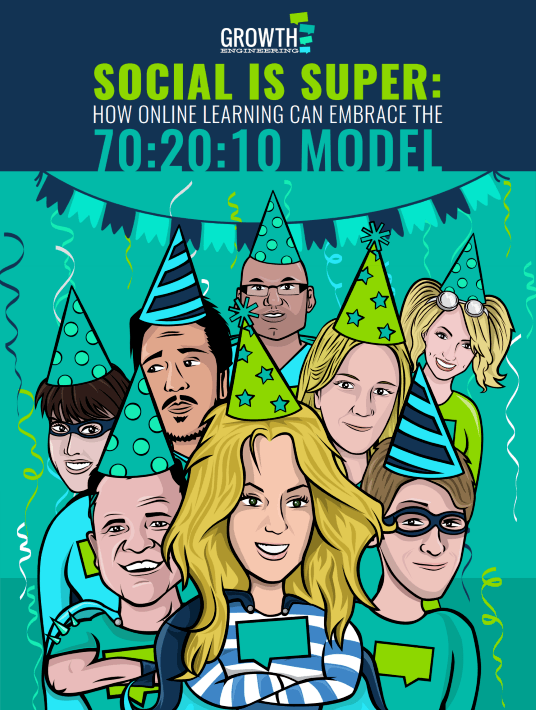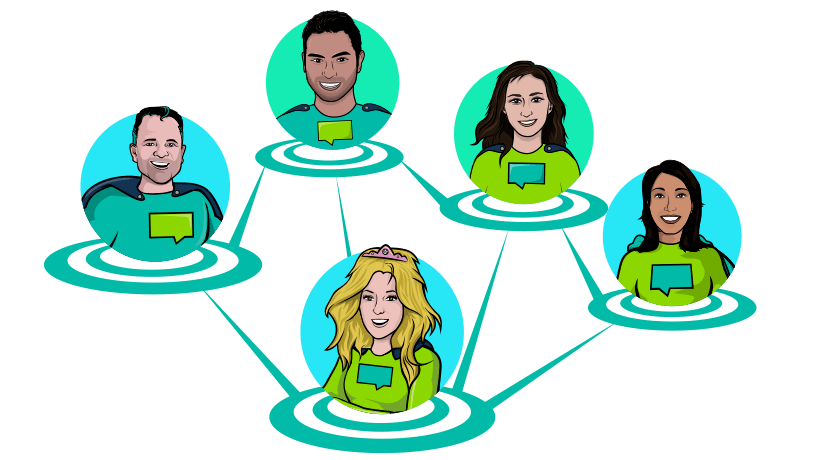Embracing The 70:20:10 Model With Social Learning: How Social Media Can Save Your Learning Program
Here’s something to mull over: Facebook’s ‘Like’ button is hit 5 billion times a day. 500 million tweets are sent every 24 hours. During that same stretch of time, 70 million photos are sent through Instagram. Social media has cured our idle thumbs for good.

Some people see social media as the ultimate time-wasting device. But what if all the hours we spent on these networks were channeled into beneficial experiences that furthered our own professional development? If you’re able to wade through all the food pictures, relationship updates, and trolling, then you’ll soon stumble across a wealth of informative content.
In most cases, setting up a social media profile is completely free and it’s accessible from a wide variety of devices. As such, social media tools can be used as a cost-effective means to support an organizational blended learning program, or embellish your online learning initiatives.
As Millennials take up more space within the global workforce, the demand for social and collaborative tools is only going to grow. With that in mind, we’ve formulated 7 top tips that will help you utilize social media to facilitate informal learning and a lot more.
1. Use Focused Facebook Or LinkedIn ‘Groups’
Group tools make it easier to connect with specific sets of people, whether they happen to be family members, friends, colleagues, or fellow learners. Why not provide your learners with their own space to share their knowledge? They could use these groups to ask and answer questions and share updates, photos, and documents with other group members. To take things to the next level, why not offer small rewards to the posts that receive the most ‘Likes’?
2. Use A Twitter #Hashtag To Focus the Conversation
Unlike Facebook and LinkedIn, all user generated messages (‘tweets’) are limited to 140 characters. This rather limits the scope of any discussion around particular learning topics. Still, that’s plenty of space for sharing important resources like images, videos, websites, and documents. Better still, Twitter’s hashtag indexing system will make all your learning content immediately searchable. Simply tag all relevant tweets and that content will be easily accessible by your whole team (and anybody else who knows the hashtag). Are you ready to make your learning content go viral?
3. Use A Blog To Help Your Learners Share Case Studies
Blogs aren’t just a place to talk about what you’ve been eating that day. They can also be used to further group learning. After all, they’re a naturally reflexive tool. They’re a bit like a modern day diary – they can be used as a record of achievements or as a means of collecting together interesting and relevant materials.
We recommend using a blogging tool to encourage your learners to share case studies that detail the effective application of training content to their day-to-day work experiences. This will help your learners to reflect upon and promote the training materials that are important to you as an organization.
4. Get Organized With A Collaborative Calendar
Social learning requires collaboration. It’s handy, then, that there are so many social tools out there that provide open calendars! Here learners can share their schedules, organize meetings, and create events that will help progress their learning programs. This is incredibly convenient if your learners need to collaborate on assignments or host discussion groups and Q&As. As the administrator, you can also add scheduled classroom or webinar training events to their shared calendar so they don’t miss a second of the action.
5. Create New YouTube Stars
Blogging is all well and good, but it’s not a patch on video-blogging. According to the Pew Research Centre, the percentage of adults posting videos online doubled between 2009 and 2013. We’re increasingly using video to discuss the topics that are important to us.
We’re not suggesting that you need to transform your learners into the next Zoella, Jenna Marbles, or PewDiePie (if you haven’t heard of these people, then congratulations!). We can’t all be stars. But we can all (most of us, anyway) embrace video and move towards creating more compelling content. This is a medium that will allow your learners to express their creativity and connect with one another on a deeper level.
Many of your learners will have a webcam on their computer, or a camera on their phone, so creating a series of video blogs might be easier than you think. If you can pull it off, your learners will get a real kick out of watching each other explain concepts, share top tips, and provide detailed case studies relating to their training material.
6. Say It With A Podcast
Unless you happen to own a recording studio, creating a podcast can be an intimidating process. Despite this, you’re still only a cheap microphone and a few ‘How to…’ guides away from becoming an iTunes legend. Once you’re set up, you have a wealth of opportunities ahead of you. Why not record group discussions and release them as podcasts so that they can be revisited on later occasions? Why not interview Subject Matter Experts within your organization and release a podcast of the conversation?
Podcasts are useful because they expand your team’s opportunities to learn. Listening to a podcast is a relatively passive experience. You can listen to a podcast whilst on your daily commute, when you’re pumping iron down at the gym, or when you’re washing dishes. If the conversation is interesting and engaging enough, they can be hugely beneficial for your learners.
7. Share It All On SlideShare
A good number of your learners will have put together a presentation or a slideshow before. For many of us, this is a part of working life. SlideShare is a tool that takes this process to the next level by encouraging us all to share our presentations.
You can imagine what this means for your learners. They now have an opportunity to share collections of images, infographics, important stats, and even case studies in a visually appealing format. They don’t have to be PowerPoint Picassos. If the content they’re sharing is informative, it will find an audience.
If you want to know more about informal learning, download the free eBook Social Is Super: How Online Learning Can Embrace The 70:20:10 Model.
Related Articles:
- Free eBook – Social Is Super: How Online Learning Can Embrace The 70:20:10 Model
- 5 Ways To Maximize ROI With Social Learning
- A 5-Step Guide To Help You Spread Social Learning Throughout Your Organization
- The Neuroscience Of Social Learning









